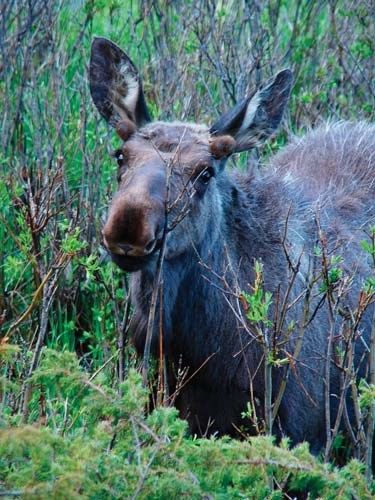Last updated: November 8, 2022
Article
Moose Summer Diet

The Question: What do moose eat during the summer in the park?
The Colorado Division of Wildlife released twelve moose (Alces alces shirasi) near Rand, CO, west of Rocky Mountain National Park in 1978-1979. This group reproduced and dispersed. The first moose were seen in the park in 1980. Today park staff estimates 61-66 moose summer here, with some being year round residents. Moose were not considered resident to the park prior to this introduction.
Moose influence the dynamics and structure of their habitat, causing changes in plant community composition and structure. Herbivory is a major concern because of the park’s large elk (Cervus elaphus) population. Park managers are concerned about the combined effects of browsing on willow (Salix sp.) by elk and moose, and the resulting impact on other animals in the ecosystem such as beaver (Castor canadensis). Knowledge of the summer diet of moose, when they are building up fat reserves for the winter and overlap in range with elk, is important for assessing the impact that moose are having on the park.
The Project: Determine the summer diet of moose by direct observation and fecal analysis.
Graduate student J.D. Dungan, from the University of Idaho, conducted a study of moose diets on the west side of the park within the Colorado River drainage during the summers of 2003 and 2004. He made direct observations of moose by 11 females and 43 males. He also collected fresh fecal pellets to determine the percentage composition of specific categories of plants in the moose diet. He sent the fecal pellets to a laboratory that calculated the percent diet composition counts of plant fragments made using a microscope. It is not uncommon for observations and fecal pellet analysis to provide somewhat different results and the methods are intended to complement each other. Fecal analysis can usually only identify plants to the genus, not the species, and direct observations are not useful for quantifying volume.
The Results: Moose browse on many different plants, and willows are the most significant component of their summer diet.
Moose ate 20 diff different kinds of plants during summer. Based on direct observations, eleven species of woody browse made up 96.9% of the summer diet. Of the woody species, six willows comprised 91.3% of summer diet; Geyer willow (S. geyeriana) was predominant, making up 45.1% of the total. Other woody browse species included alder (Alnus incana), quaking aspen (Populus tremuloides), and bog birch (Betula glandulosa). Dungan observed moose eating non-woody aquatic plants, forbs (broad-leaved herbaceous plants such as dandelion), and grasses.
Somewhat in contrast, fecal analyses revealed that willows comprised 79.3% of moose diets, 11.9% less than that recorded from direct observation of moose feeding. Further, fecal pellet analyses revealed that the aquatic sedge (Carex spp.) was important in moose diets, although moose were not observed eating sedges.
Species diversity of food peaked in July when 18 different plants were utilized. Moose use riparian willow communities during the summer, which contain limited areas of aquatic vegetation or forbs. The park is planning winter moose survey work to complement this summer study.
This summary is based on published, peer-reviewed and/or unpublished reports available at the time of writing. It is not intended as a statement of park policy or as a definitive account of research results.
For more information on the park’s research program, see www.nps.gov/romo
Written by: Bert Cushing Date: 12/31/08 Photo credit: Copyright by Phillipe Henry
